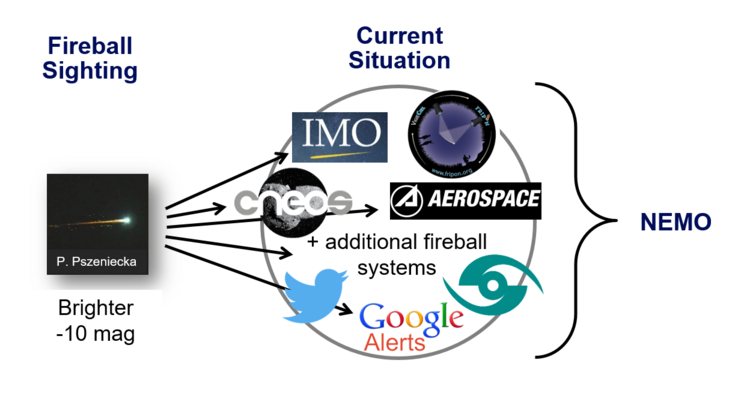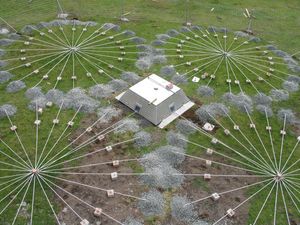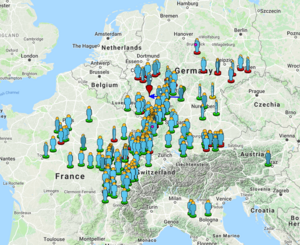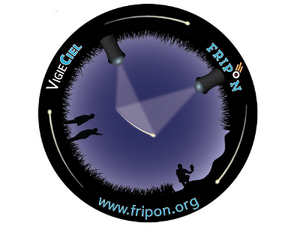NEMO
NEMO
Esther Drolshagen1, Theresa Ott1, Detlef Koschny2,3, Gerhard Drolshagen1, Jeremie Vaubaillon4, Pierrick Mialle5, Christoph Pilger6, and Björn Poppe1
1University of Oldenburg
22ESA/ESTEC, 2201 AZ Noordwijk ZH, The Netherlands
3Chair of Astronautics, TU Munich, Germany
4Observatoire de Paris, France
5CTBTO PTS/IDC, Vienna International Center
6BGR, Hannover, Germany
On average 54 tons of extra-terrestrial material reaches the Earth per day. It is for the most part either interplanetary dust, meteoroids, or asteroids (Drolshagen et al. 2017).
Fast objects with at least a few millimetre in size are the source for meteors when they enter the Earth atmosphere. Only the largest objects with at least some tens of centimetres produce fireballs which are extremely bright and highly visible.
The objective of this project is to create a global near real-time fireball monitoring system called NEMO (NEar real-time MOnitoring system).
Even though there are several ground-based networks designed to monitor meteors and fireballs optically or by radar, there is no combined database of world-wide events. This will only be possible with data from a large number of projects, since most meteor observation methods are locally confined.
The NEMO alert system often obtains its initial information from social media, which can be used to obtain fast and world-wide data. There is a coordination of NEMO and the FIS (Fireball Information System) from ESAs (European Space Agency) near-Earth object Coordination Centre (NEOCC). The main interest is in fireballs brighter -10 mag (reversed logarithmic brightness scale, Vega has a brightness of 0 mag, the Sun of about -27 mag).
Cooperation with all kinds of networks would be most welcome.

The purpose of NEMO (FRIPON (Fireball Recovery and InterPlanetary Observation Network), IMO (International Meteor Organization), CNEOS (Center for Near Earth Object Studies)).
FRIPON
The french Fireball Recovery and InterPlanetary Observation Network (FRIPON) consists (Dezember 2017) of more than 110 cameras, covering most of the sky over France. Multistation detections of fireballs of this system yield a lot of scientific output including a high quality trajectory and a strewn field which can be used to search for possible meteorites of a certain event.
One FRIPON camera is placed on the roof of the University at the Campus Wechloy. Further cameras are planned to be installed in the surrounding area, thus including the north of Germany into the network.
CTBTO

The Comprehensive Nuclear Test Ban Treaty Organisation (CTBTO) ensures the compliance with international treaties prohibiting the tests of nuclear weapons. Their International Monitoring System (IMS) monitors i.e. the Earth atmosphere to look for signs of nuclear explosions in the infrasound spectrum. They operate infrasound stations all around the world looking for explosion signatures in the waveform which are similar to the ones created by fireballs.
Using their infrasound data it is possible to locate fireballs in the atmosphere and to determine a source energy.
A collaboration with the BGR (Federal Institute for Geosciences and Natural Resources) as the German National Data Center for the verification of the CTBT was established to investigate CTBTO IMS infrasound data with respect to large fireball signatures.
IMO - Fireball sightings

The International Meteor Organisation (IMO) has developed a very useful and intuitive tool to report fireballs. This tool collects fireball sightings submitted by members of the general public who saw an interesting event from all over the world. The observation reports are grouped and become so accurate that in some cases it is possible to determine a fireball trajectory.
If you have seen a fireball you would like to report please follow this link: fireball.imo.net/members/imo/report_intro
If you are interested in writing a Bachelor’s or Master’s thesis connected to this topic please contact Esther Drolshagen, Theresa Ott, Dr. Gerhard Drolshagen, Prof. Dr. Björn Poppe, or our external partner: Dr. Detlef Koschny (ESA).





